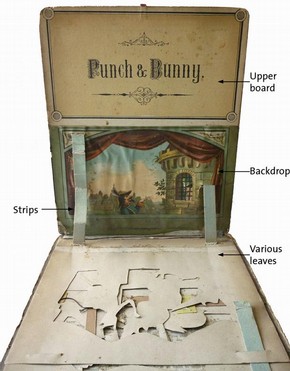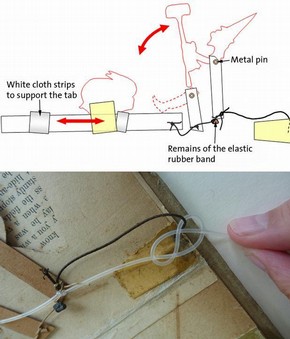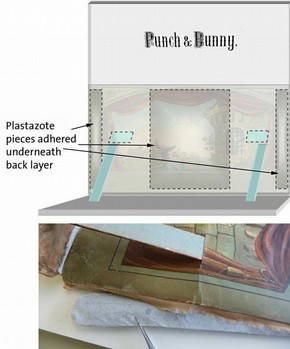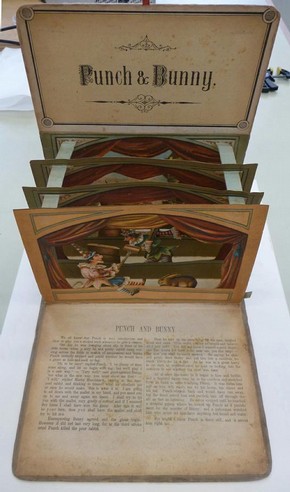Conservation Journal
Spring 2012 Issue 60
Punch and Bunny: conservation of a pop-up theatre book
Clémentine Desmond
Book Conservation Intern

Figure 1 - Punch and Bunny before conservation, published by McLoughlin, about 1880s. Museum no. S.1167-2010
Ask any children about pop-up books and they will probably tell you they had the most incredible experience reading one. What seems nowadays to be an inexhaustible source of entertainment was originally a tough challenge for the creators of these books.
Over the years artists, paper engineers and book designers have continually defied the two dimensional limits of the leaf by adding tabs, flaps and other movable parts to produce the pop-up. The earliest known examples are the ‘volvelles’ or revolving discs. Developed in the 13th century, they were used to demonstrate the changing star patterns in the sky. ‘Metamorphoses’ or ‘harlequinades’, produced in the 18th century, were the first pop-up adaptations made specifically for children. These books employed a system of flaps which opened upwards or downwards to reveal hidden images or text. At the turn of the 20th century, movable books evolved into more sophisticated pop-ups; varying in designs these often limited editions were still quite experimental.
Theatre Collection’s Punch and Bunny (S.1167-2010) is a late 19th century ‘multiple layer’ or ‘stage set’ structure resembling the Little Showman’s series, published by McLoughlin around the 1880s.
The object is made up of two boards hinged along the head edge. When opened, a mechanism of card strips raises the inner leaves to create a multi layered stage set with the proscenium arch at the front and the back drop lining the inside of the upper board (Figure 1). The proscenium arch leaf includes a tab which operates a mechanism that moves Punch’s arm and leg whilst pulling the bunny back and forth (Figure 2). At first, the principle seems rather simple, however, numerous parts are required to make the book work and when one of those is damaged, the whole system collapses.
When the book arrived in the studio the strips of card supporting the leaves were detached, creased and weak and the leaves were no longer able to stand upright. The back drop, drummed to the upper board, was tearing and suffering from planar distortion. Moreover, the movable parts of the mechanism were not operating properly when pulling the tab.
After a brief condition assessment, it quickly appeared that it would be necessary to undertake full conservation, which would involve reconstructing the book, in order to restore its original function. Due to the book’s complexity, it was important to understand the mechanics of the structure and the function of the individual parts. A diagram was drawn which helped identify the places where tensions, pressures, and frictions were causing damage (mainly due to inappropriate design and bad handling):
- the slits allowing the passage of the strips were too thin for the card thickness
- on opening the book the back drop pulled forward almost one centimeter
- the concave curve of the lower board was causing damage to the leaves when opening
- the rubber band used to pull back the mechanism had perished
To be conserved the book was taken apart. The strips and the leaves were released mechanically from the boards, their tears and weaknesses repaired and supported with matching toned Japanese paper. The boards were then relaxed using Gore-Tex® and flattened under weight.
The badly damaged back drop was lifted using a steam pencil and a thin spatula, the dense layer of animal glue was reduced with moist cotton buds and it was then humidified inside a Gore-Tex® sandwich in order to relax and flatten the paper. After drying under weights, the tears were repaired with a medium weight Japanese paper and lined with a light Tengujo paper using thin wheat starch paste.
Three main problems arose:
- how to support the background slits and prevent them from tearing whilst allowing the strips to slide when operating the book. A laminate of Nylon Gossamer and Tengujo paper adhered with Vinamul® 3252 EVA was chosen because of its good ratio of strength to thickness.1 A cut with a small diameter hole punched out at each end was made to the repair pieces before adhering them in position. All other slits in the leaves were supported in the same way.
- remounting the back drop. As stated before, opening the lower strip ends caused the back drop to billow out but collapse in the centre. A padding had to be designed to support it and counteract these tensions. A 5mm LD45 Plastazote polyethylene foam was chosen as soft, strong and inert. Three pieces were cut, bevelled and melted with a hot spatula on each edge to make them smoother, wrapped in Japanese paper and adhered with wheat starch paste between the upper board and back drop. One was positioned in the centre and one along the left and right edges (Figure 3). Finally, the back drop was drummed to the upper board using toned Japanese paper v-hinges.
- to find an inert, elastic material to replace the perished rubber band. A 1.5mm diameter silicone cord was sourced as the best solution. Simply knotted to the mechanism it operates the pull-back movement perfectly.
After conservation, although still needing to be handled with care, the book is able to be opened and closed without elements tearing or breaking. The layers and the mechanism have regained their role and the object its meaning (Figure 4).
In order to repair such an unusual three dimensional object it was necessary to consider, adopt and adapt both traditional and new materials which offer the necessary qualities. The complexity of this object provided the opportunity to experiment to find an innovative solution through research and discussion with colleagues in the Conservation Department.
Acknowledgements
I am grateful to my colleagues in the Book, Paper and Preservation Conservation Studios.
Reference
(1) Rutherston, J., Laminates for repairing guards in albums (MA research, 1997)
Spring 2012 Issue 60
- Editorial
- Mahasiddha Virupa: an exploration
- Science Section supports the Public Programme
- REMAI: the European Network of Museums of Islamic Art
- Positive Negative
- Cutting character: research into innovative mannequin costume supports in collaboration with the Royal College of Art Rapid Form Department
- The Alhambra Court fire surround
- Moving Meleager
- Utilising skills and creating opportunities
- Preserving intangible integrity
- Re-housing alabasters: an altarpiece framework mount
- Cinderella table
- Bombay Blackwood
- Punch and Bunny: conservation of a pop-up theatre book
- The technical examination and conservation treatment of Portrait of a Lady by Francesco Morandini
- Conservation of a child’s fairy costume
- Conservation 'on a roll'
- Editorial board & Disclaimer


